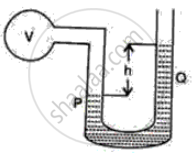Advertisements
Advertisements
Question
Assertion: Pascal’s law is the working principle of a hydraulic lift.
Reason: Pressure is thrust per unit area.
Options
If both assertion and reason are true and reason is the correct explanation of assertion.
If both assertion and reason are true but reason is not the correct explanation of assertion.
If assertion is true but reason is false.
If assertion is false but reason is true.
Solution
If both assertion and reason are true but reason is not the correct explanation of assertion.
APPEARS IN
RELATED QUESTIONS
Define one pascal (Pa), the S.I. unit of pressure.
Explain the principle of a hydraulic machine. Name two devices which work on this principle.
At a given place, a barometer records 70 cm of Hg. If the mercury in the barometer is replaced by water, what would be resulting in reading? (Density of Hg = 13600 kg/m3; Density of water = 1000 kg/m3)
The pressure in the water pipe on the ground floor of a building is 40000 pascals, whereas on the first floor it’s 10000 pascals. Find the height of the first floor. (Acceleration due to gravity g = 10 ms−2)
How does the liquid pressure on a diver change according to the following condition:
When the driver moves horizontally
How does the liquid pressure on a diver change according to the following condition:
When the driver moves to the greater depth?
The following figure shows a manometer containing a liquid of density p. The limb P of the manometer is connected to a vessel V and the limb Q is open to atmosphere. The difference in the levels of liquid in the two limbs of the manometer is h as shown in the diagram. The atmospheric pressure is P0.
(i) What is the pressure on the liquid surface in the limb Q?
(ii) What is the pressure on the liquid surface in the limb P?

Name three applications of Pascal's law.
Do all liquids exert pressure?
State Pascal’s law.
